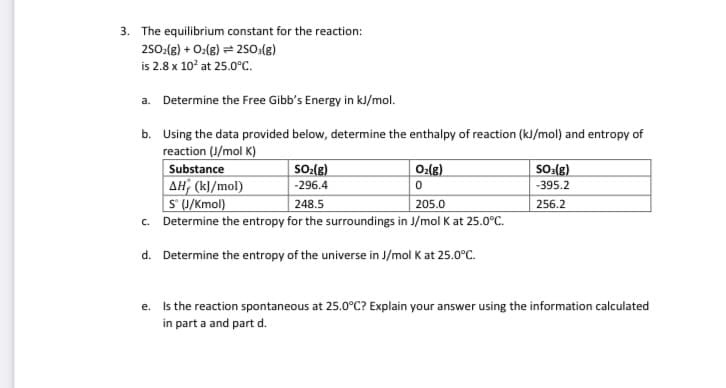3. The equilibrium constant for the reaction: 250:(8) + O:(8) = 2s0,(8) is 2.8 x 10' at 25.0°C. a. Determine the Free Gibb's Energy in kJ/mol. b. Using the data provided below, determine the enthalpy of reaction (k)/mol) and entropy of reaction (J/mol K) Substance SO:() O:(8) AH, (kl/mol) S' (J/Kmol) c. Determine the entropy for the surroundings in J/mol K at 25.0°C. (3)*Os -296.4 -395.2 248.5 205.0 256.2 d. Determine the entropy of the universe in J/mol K at 25.0°C. e. Is the reaction spontaneous at 25.0°C? Explain your answer using the information calculated in part a and part d.
3. The equilibrium constant for the reaction: 250:(8) + O:(8) = 2s0,(8) is 2.8 x 10' at 25.0°C. a. Determine the Free Gibb's Energy in kJ/mol. b. Using the data provided below, determine the enthalpy of reaction (k)/mol) and entropy of reaction (J/mol K) Substance SO:() O:(8) AH, (kl/mol) S' (J/Kmol) c. Determine the entropy for the surroundings in J/mol K at 25.0°C. (3)*Os -296.4 -395.2 248.5 205.0 256.2 d. Determine the entropy of the universe in J/mol K at 25.0°C. e. Is the reaction spontaneous at 25.0°C? Explain your answer using the information calculated in part a and part d.
Chemistry for Engineering Students
4th Edition
ISBN:9781337398909
Author:Lawrence S. Brown, Tom Holme
Publisher:Lawrence S. Brown, Tom Holme
Chapter10: Entropy And The Second Law Of Thermodynamics
Section: Chapter Questions
Problem 10.104PAE: 10.104 (a) When a chemical bond forms, what happens to the entropy of the system? (b)...
Related questions
Question
Just need help with D and E of question

Transcribed Image Text:3. The equilibrium constant for the reaction:
250:(g) + O:(g) = 2so:(g)
is 2.8 x 10° at 25.0°c.
a. Determine the Free Gibb's Energy in kJ/mol.
b. Using the data provided below, determine the enthalpy of reaction (kJ/mol) and entropy of
reaction (J/mol K)
Substance
SO:(g)
0:(g)
SO:(g)
AH; (kl/mol)
S U/Kmol)
c. Determine the entropy for the surroundings in J/mol K at 25.0°C.
-296.4
-395.2
248.5
205.0
256.2
d. Determine the entropy of the universe in J/mol K at 25.0°C.
e. Is the reaction spontaneous at 25.0°C? Explain your answer using the information calculated
in part a and part d.
Expert Solution
This question has been solved!
Explore an expertly crafted, step-by-step solution for a thorough understanding of key concepts.
This is a popular solution!
Trending now
This is a popular solution!
Step by step
Solved in 7 steps with 1 images

Knowledge Booster
Learn more about
Need a deep-dive on the concept behind this application? Look no further. Learn more about this topic, chemistry and related others by exploring similar questions and additional content below.Recommended textbooks for you

Chemistry for Engineering Students
Chemistry
ISBN:
9781337398909
Author:
Lawrence S. Brown, Tom Holme
Publisher:
Cengage Learning

Chemistry: The Molecular Science
Chemistry
ISBN:
9781285199047
Author:
John W. Moore, Conrad L. Stanitski
Publisher:
Cengage Learning

Chemistry & Chemical Reactivity
Chemistry
ISBN:
9781337399074
Author:
John C. Kotz, Paul M. Treichel, John Townsend, David Treichel
Publisher:
Cengage Learning

Chemistry for Engineering Students
Chemistry
ISBN:
9781337398909
Author:
Lawrence S. Brown, Tom Holme
Publisher:
Cengage Learning

Chemistry: The Molecular Science
Chemistry
ISBN:
9781285199047
Author:
John W. Moore, Conrad L. Stanitski
Publisher:
Cengage Learning

Chemistry & Chemical Reactivity
Chemistry
ISBN:
9781337399074
Author:
John C. Kotz, Paul M. Treichel, John Townsend, David Treichel
Publisher:
Cengage Learning

General Chemistry - Standalone book (MindTap Cour…
Chemistry
ISBN:
9781305580343
Author:
Steven D. Gammon, Ebbing, Darrell Ebbing, Steven D., Darrell; Gammon, Darrell Ebbing; Steven D. Gammon, Darrell D.; Gammon, Ebbing; Steven D. Gammon; Darrell
Publisher:
Cengage Learning


Chemistry
Chemistry
ISBN:
9781305957404
Author:
Steven S. Zumdahl, Susan A. Zumdahl, Donald J. DeCoste
Publisher:
Cengage Learning